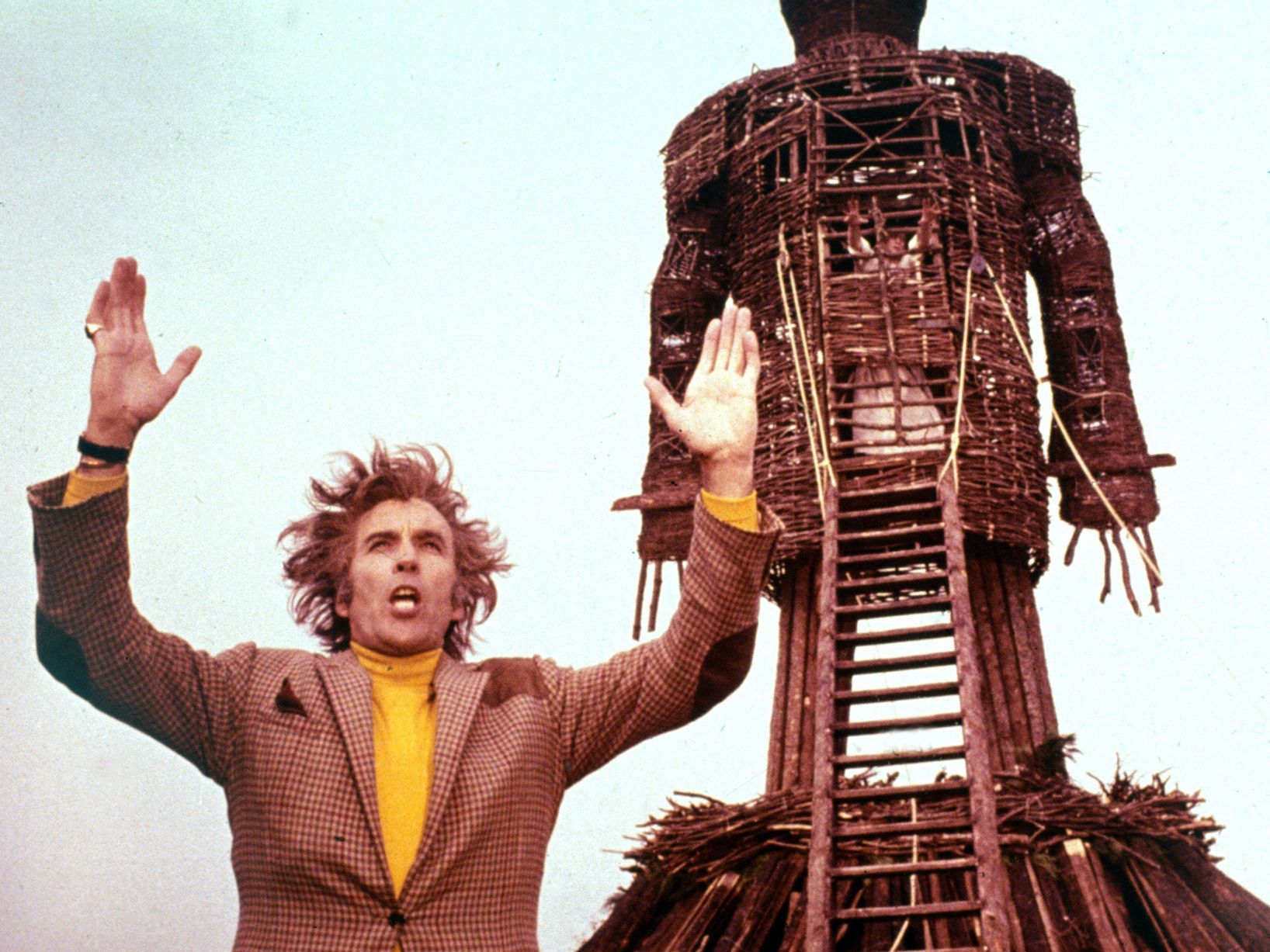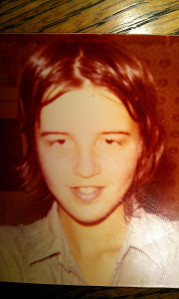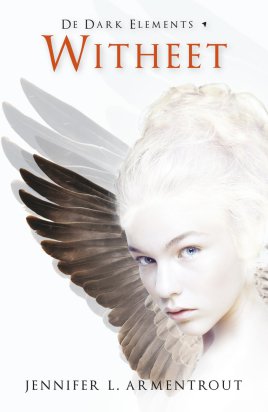
I’m already excited about this new series. I’m loving the chance of a Sunday morning to slip into an oasis of time and go somewhere for the duration. I have so rarely watched entertainments of this duration in recent years.
Indeed, in this dreary and ill week, I several times found myself wanting to dip into the pile, sneak in another film, nestle comfortably into it.
That said, the idea of random selection has already had to be tweaked, since my first two attempts both lit upon French films again, one of them a most frustrating choice. So it had to be a case of Third Time Lucky, and this time I drew Anthony Shaffer and Robin Hardy’s 1973 classic, The Wicker Man.
I first saw it on its original theatrical release, in the glorious old days of double bills, as the B-movie to Nic Roeg’s terrifying Don’t Look Now (which we’ll also be seeing this year), which makes it not only one of the very best double bills I ever saw but places it very firmly as one of the earliest trips to our local Odeon in Burnage once I managed to graduate to ‘adult’ films.
The Wicker Man is both famous and infamous, the latter for its back-story. It began with a conversation between writer Anthony Shaffer and star Christopher Lee over the latter wanting to escape his image as a Hammer horror star. Shaffer was interested in alternate themes for horror, without the overt blood and violence. With Robin Hardy aboard as Director, the film was made as a loose adaptation of a 1967 novel by David Pinner, Ritual.
Originally, the film was shot in a 99 minute print but was not well-received by the new studio boss, who told Christopher Lee that it was the worst film he’d even seen. Lee, who believed passionately in the film, to the extent of having worked on the same for free, remained determinedly behind it. In the end, an 87 minute version, with some story re-ordering that all felt damaged the continuity, was released to cinema. The original 99 minute version has been lost for decades (according to Alex Cox, the negative was buried in a support pylon on the M4, to get rid of it).
It was also rumoured that Rod Stewart was trying to buy up all prints of the film, to prevent anyone ever seeing again the famous nude dance scene by his then girlfriend, Britt Ekland.
However, down the decades, various attempts have been made to restore the original film as closely as possible. My own DVD is ‘The Director’s Cut’, a double DVD with the Theatrical Release on one Disc and a 95 minute Directors cut, taken from one-inch telecine videotape. The picture quality is ropey, and as many scenes are possible are cut in from the Theatrical version. Subsequently, there’s been a four disc Final Cut, a four-disc (three DVD, one soundtrack CD) set with a higher quality restored version 91 minutes in length, which I’ve yet to acquire.
Naturally enough, today’s viewing was of the Director’s Cut, as the longest length version ever released.
Given the film’s age and notoriety, I’m not going to go into any great detail about its story. Edward Woodward, in his first major film role, plays Sergeant Neil Howie, a committed Christian, who is called to the privately owner West Highland isle of Summerisle, famed for its exceptional apple crops, to investigate the apparent disappearance, months earlier, of 12 year old Rowan Morrison. Howie is shocked to find the island a haven of paganism, its Christan Church de-consecrated and, to his mind, defiled. Sexuality is robust and open.
At first, the islanders deny Rowan’s existence. Even after Howie proves her to be an island girl, they consistently act as if he is poking into matters that he cannot understand and which are none of his business.
The island is ruled, with a gentle feudal control, by Lord Summerisle (Lee) who frankly confesses to Howie that the island’s fruitfulness has scientific origins going back a century to his grandfather, who recognised Summerisle’s unique properties for growing new strains of fruit, and who grafted paganism, with its nature roots and its worship of old gods more life-enhancing than the dour Scottish Christian God of Howie’s reverence, onto the populace to inspire them as workers. The current Summerisle’s father, raised a pagan, continued the work with belief. We are (a superb touch) never entirely certain how wholehearted a pagan the current Lord may be.
What Howie finds is that the previous year’s crops failed, disastrously. He comes to the conclusion that on Mayday, Summerile and the islanders plan a human sacrifice to propitiate their pagan gods, and that this is to be Rowan. He is half right.
The film skillfully plays along with Howie. He is in virtually every scene, even if only as observer, and the story unfolds for us exactly as it does for him. Woodward is absolutely brilliant. His stiff, buttoned-up anger, his rejection of everything he sees around him as an offence against his God, and his inability to see beyond his own self-selected perceptions is conveyed with beautiful minimalism. His performance holds the film together.
On the other hand, and I’m assuming this to be deliberate, although his final desperate scene brings tears to the eyes, Howie’s unwavering belief in his almost masochistically restrictive religion does Christianity no favours at all. At the end of the film, when it is revealed that human sacrifice is the intention, it is also revealed that Howie is the intended victim, that he is uniquely place to satisfy the requirements of the victim: he is the Willing King Fool Virgin, and he has been selected by Summerisle for all these things, and every single moment he has been on the island, pursuing his task with the righteousness of bth the Law and a pure-hearted Christian, he has been expertly manipulated to come, of his own accord, to the place of sacrifice.
This is the Wicker Man. It’s first spoken of literally seconds before it is seen, and we see Howie see it before we see it ourselves. It is a giant wicker man-like shape, on a sea cliff, featureless and towering and horrifying to look at. It is a cage, multiple cages, animals in its head, its legs, its arms and a cavity in its torso for its central sacrifice: Sergeant Neil Howie.
This is an intense film, full of detail, full of music, composed and directed by Paul Giovanni, out of folk music, some traditional, some hybrids, some original, but all so utterly intrinsic to the place, the time, the feel. The islanders are deliberate eccentrics throughout, but realistic ones. This is a closed community and Howie is the outsider. It has its fair share of beauties: Ekland is Willow McGregor, the landlord’s daughter (about whom there’s a memorably ribald song that embarrassed me at the age of seventeen), Diane Cilento (Sean Connery’s ex-wife, who went on to marry Shaffer) is Miss Rose, the painfully enthusiastic schoolteacher, and Ingrid Pitt (another Hammer Horror star and, less well-known, concentration camp survivor) as the unnamed Librarian.
Ekland’s famous nude scene, in which she sings to tempt Howie into her room (and bed) has several background elements to it. As Ekland was three months pregnant at the time, the camera had to be kept away from her stomach (with much screaming by Hardy every time it neared a critical line, as I once read). What’s more, Ekland’s contract permitted only topless nudity, and Hardy had promised not to slip in any bum-shots. Which meant that as soon as she left the set for the day, a body-double was sneaked in to film the writhing scenes that required Willow’s backside to gyrate so uninhibitedly. (According to Wikipedia, two body doubles were used, one being Lorraine Peters, who has a tiny role in the film as a naked woman straddling a grave, and the other an extra named Jane Jackson).
(Incidentally, Ekland’s singing in this scene is dubbed by Rachel Verney, as her speaking voice in the film is dubbed by Annie Ross, to provide a Scottish accent. The excellent bosom is definitely Ekland, however.)
What’s more, though Shaffer and Hardy planned this scene to occur on the eve of Mayday, as a final temptation for Howie on the night before the sacrifice, in the theatrical release it is shifted forward to his first night on the island (replacing a scene where Willow ‘initiates’ a teenage boy at the instance of Lord Summerisle, and thus postponing Lee’s first appearance onscreen until the middle of the film). In this place, it becomes just sex for sex’s sake instead of being an ultimate test of Howie’s faith. And in the Theatrical release, we don’t have the cut early scene that establishes that Howie, despite two year’s engagement, has yet to take his pleasure of the fair Mary Bannoch.
It is, I say again, a great film. Watching The Director’s Cut is an uneasy experience, due to the frequent and jarring changes in filmstock quality, each of which recalls you to the fact you’re watching a film, which is the one thing all good films should avoid doing. The best effect is to be absorbed into the film, not constantly kept out of it. If The Final Cut is of a consistent quality, and the running order Shaffer and Hardy always intended, it could well be the best version of them all.
To be honest, I did wonder at times, this morning, whether the Theatrical Release isn’t better anyway. Long before I ever saw the extended version, I enjoyed the film immensely, and never thought for a moment that I was missing anything, or failed to understand the film. What’s re-added in The Director’s Cut is detail: convincing, consistent and well-planned detail, but little if anything that transforms the film or provides unexpected revelations. It’s some time since I’ve watched the Theatrical Release: I shall have to do so.
Once again, thank you for watching.
Advertisements Share this:




